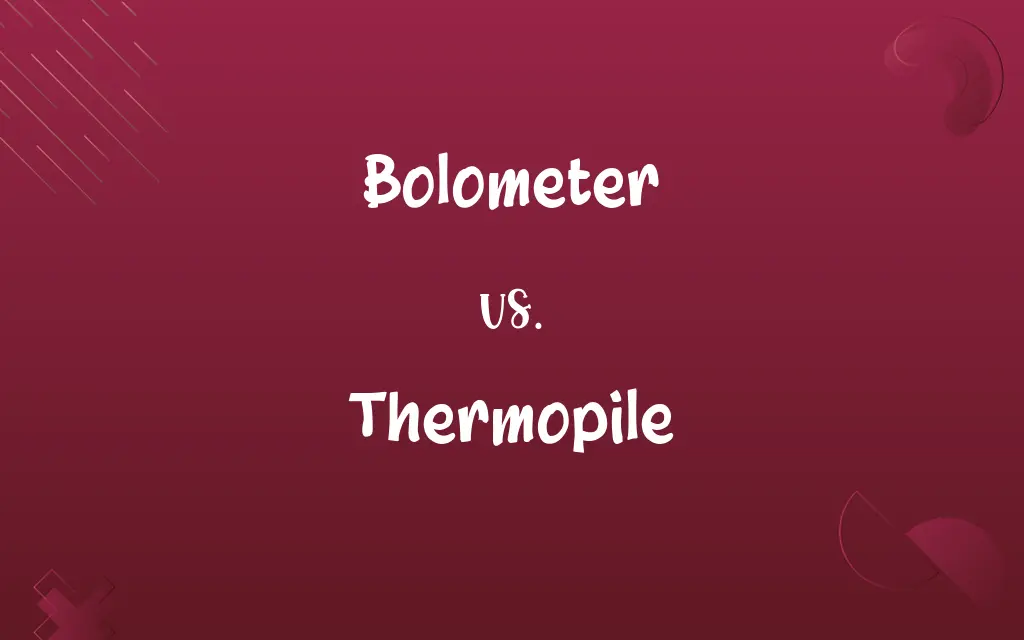Bolometer vs. Thermopile: Know the Difference

By Shumaila Saeed & Hifza Nasir || Updated on March 7, 2024
A bolometer measures electromagnetic radiation intensity through temperature change, while a thermopile detects temperature differences by converting thermal energy into electrical voltage.

Key Differences
A bolometer is a device designed to measure the intensity of electromagnetic radiation, from visible light to infrared and microwave, by observing the temperature increase in a material absorbing the radiation. This temperature change affects the electrical resistance of the bolometer's material, which is measured to determine the radiation's intensity. Thermopiles, in contrast, consist of several thermocouples connected in series or parallel to measure temperature differences across a distance. They generate a voltage in response to a temperature gradient, allowing for the detection of heat flow or the intensity of infrared radiation without direct contact.
Hifza Nasir
Mar 07, 2024
Bolometers are highly sensitive and can detect minute changes in temperature, making them suitable for applications in astrophysics, infrared imaging, and security. Thermopiles are widely used in non-contact infrared thermometers, heat flux sensors, and gas detection, benefiting from their ability to measure temperature differences over an area or point without physical contact.
Shumaila Saeed
Mar 07, 2024
The key to a bolometer's functionality lies in its absorptive element, typically made of materials like metals or semiconductors, which undergoes a change in resistance when heated. Thermopiles rely on the Seebeck effect, where a voltage is generated across different materials at different temperatures, to measure thermal radiation or temperature gradients.
Shumaila Saeed
Mar 07, 2024
In terms of application, bolometers require cooling to very low temperatures in many cases, especially for detecting faint astronomical signals, to increase their sensitivity by reducing thermal noise. Thermopiles, being less sensitive to absolute temperature changes, do not usually require cooling and are therefore simpler and more robust for industrial or consumer applications.
Shumaila Saeed
Mar 07, 2024
Both bolometers and thermopiles translate thermal energy into measurable electrical signals, but they operate on different principles and are suited to different types of measurements. Bolometers focus on detecting the intensity of electromagnetic radiation through the resultant temperature change in a material, while thermopiles measure temperature differences across an object or area to convert thermal energy into electrical voltage.
Hifza Nasir
Mar 07, 2024
ADVERTISEMENT
Comparison Chart
Principle
Measures radiation intensity through temperature-induced resistance change
Converts temperature differences into electrical voltage
Shumaila Saeed
Mar 07, 2024
Sensitivity
Highly sensitive to small temperature changes
Sensitive to temperature gradients, not absolute values
Hifza Nasir
Mar 07, 2024
Applications
Astrophysics, infrared imaging, security
Non-contact thermometers, heat flux sensors, gas detection
Shumaila Saeed
Mar 07, 2024
Operating Mechanism
Change in electrical resistance
Seebeck effect (voltage generation from temperature difference)
Shumaila Saeed
Mar 07, 2024
Cooling Requirement
Often requires cooling for high sensitivity
Typically does not require cooling
Hifza Nasir
Mar 07, 2024
ADVERTISEMENT
Bolometer and Thermopile Definitions
Bolometer
Highly sensitive, often cooled for precision.
The laboratory bolometer is cooled to near absolute zero to detect faint infrared signals.
Shumaila Saeed
Mar 07, 2024
Thermopile
Consists of several thermocouples.
The thermopile's multiple thermocouples enhance its sensitivity to temperature gradients.
Hifza Nasir
Mar 07, 2024
Bolometer
Used in astrophysics and security imaging.
Airport security employs bolometers for non-invasive body scanning.
Hifza Nasir
Mar 07, 2024
Thermopile
Generates voltage from temperature differences.
A thermopile sensor in a digital thermometer measures skin temperature without contact.
Shumaila Saeed
Mar 07, 2024
Bolometer
Detects a wide range of radiation.
Bolometers are versatile, measuring from visible light to microwaves.
Dua Fatima
Mar 07, 2024
ADVERTISEMENT
Thermopile
Suitable for industrial applications.
Thermopiles monitor the temperature of machinery to prevent overheating.
Hifza Nasir
Mar 07, 2024
Bolometer
Measures electromagnetic radiation by temperature changes.
Scientists use bolometers to study cosmic microwave background radiation.
Shumaila Saeed
Mar 07, 2024
Thermopile
Used in non-contact infrared thermometers.
Doctors use thermopile-based thermometers for quick, hygienic temperature checks.
Shumaila Saeed
Mar 07, 2024
Bolometer
Changes in resistance indicate radiation intensity.
A bolometer's resistance increases when it absorbs infrared light from a distant star.
Dua Fatima
Mar 07, 2024
Thermopile
Measures heat flow or infrared radiation.
Environmental scientists use thermopiles to study heat flux in ecosystems.
Shumaila Saeed
Mar 07, 2024
Bolometer
An instrument that measures radiant energy by correlating the radiation-induced change in electrical resistance of a blackened metal foil with the amount of radiation absorbed.
Shumaila Saeed
Oct 19, 2023
Thermopile
A device consisting of a number of thermocouples connected in series or parallel, used for measuring temperature or generating current.
Shumaila Saeed
Oct 19, 2023
Bolometer
(physics) A sensitive device for detecting and measuring the energy of electromagnetic radiation.
Shumaila Saeed
Oct 19, 2023
Thermopile
(electronics) An electronic device that converts thermal energy into electrical energy. Usually constructed using a series-combination of thermocouples
Shumaila Saeed
Oct 19, 2023
Bolometer
An instrument for measuring minute quantities of radiant heat, especially in different parts of the spectrum; - called also actinic balance, thermic balance.
Shumaila Saeed
Oct 19, 2023
Thermopile
An instrument of extreme sensibility, used to determine slight differences and degrees of heat. It is composed of alternate bars of antimony and bismuth, or any two metals having different capacities for the conduction of heat, connected with an astatic galvanometer, which is very sensibly affected by the electric current induced in the system of bars when exposed even to the feeblest degrees of heat.
Shumaila Saeed
Oct 19, 2023
Thermopile
A kind of thermometer for measuring heat radiation; consists of several thermocouple junctions in series
Shumaila Saeed
Oct 19, 2023
Repeatedly Asked Queries
Are thermopiles used in everyday devices?
Yes, thermopiles are used in many everyday devices, including non-contact infrared thermometers and residential gas detectors.
Dua Fatima
Mar 07, 2024
How do the applications of bolometers and thermopiles differ?
Bolometers are used for scientific research and sensitive security applications, requiring precise measurements of electromagnetic radiation. Thermopiles are more commonly found in industrial, medical, and consumer products for temperature measurement and heat detection.
Hifza Nasir
Mar 07, 2024
Can bolometers measure temperature?
While primarily used to measure radiation intensity, bolometers indirectly measure temperature through the resistance changes of their absorptive material due to heating.
Shumaila Saeed
Mar 07, 2024
Why do bolometers need to be cooled?
Cooling bolometers reduces thermal noise, significantly increasing their sensitivity and enabling the detection of very faint electromagnetic signals.
Shumaila Saeed
Mar 07, 2024
What makes a bolometer sensitive?
A bolometer's sensitivity comes from its absorptive material that changes resistance with very slight temperature increases, allowing it to detect minimal radiation intensities.
Hifza Nasir
Mar 07, 2024
How do thermopiles detect temperature without contact?
Thermopiles detect temperature gradients by converting thermal energy from a distance into electrical voltage, allowing for non-contact measurement.
Shumaila Saeed
Mar 07, 2024
Can a thermopile measure absolute temperature?
Thermopiles measure temperature differences rather than absolute temperatures, but they can infer absolute temperatures in certain calibrated systems.
Dua Fatima
Mar 07, 2024
How does the Seebeck effect work in thermopiles?
The Seebeck effect occurs when two different conductors form a circuit and are exposed to different temperatures, generating voltage at the junctions.
Shumaila Saeed
Mar 07, 2024
What types of materials are used in bolometers?
Materials like superconductors, semiconductors, and metals, known for their temperature-dependent resistance, are used in bolometers.
Hifza Nasir
Mar 07, 2024
Can bolometers and thermopiles be used together?
Yes, in some applications, bolometers and thermopiles might be used together to complement each other's measurements, combining radiation intensity detection with temperature gradient measurement.
Hifza Nasir
Mar 07, 2024
Share this page
Link for your blog / website
HTML
Link to share via messenger
About Author
Written by
Shumaila SaeedShumaila Saeed, an expert content creator with 6 years of experience, specializes in distilling complex topics into easily digestible comparisons, shining a light on the nuances that both inform and educate readers with clarity and accuracy.
Co-written by
Hifza Nasir








































































